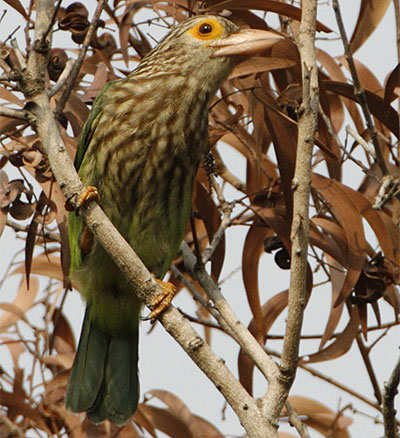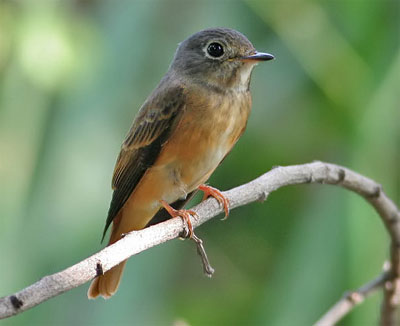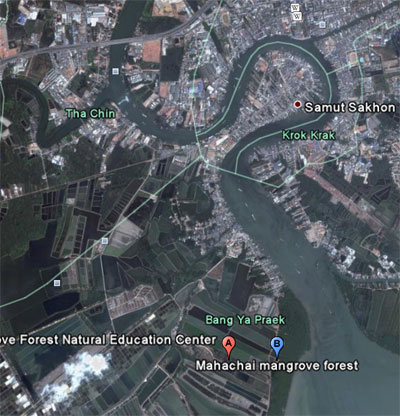Although Suan Rot Fai seemed to be producing some good birds and with a report of Grey-backed and Tiger Shrike in Lumphini Park heading to one of Bangkok's parks seemed like the thing to do, but then I remembered Phuttamonton. This is a huge park just outside the western bounds of Bangkok in Nakorn Pathom province and although it is largely manicured, it is so big that one can always find some unkempt areas that could attract passage migrants.
Resident Birds Phuttamonton Park is not particularly rich in resident species, playing host to mostly very common birds such as Common Myna, White-vented Myna, Cattle Egret, Indian Roller, Red-wattled Lapwing, Large-billed Crow, Paddyfield Pipit, Black-crowned Night Heron, Pied Fantail and Oriental Magpie Robin. Whilst I saw all of these there were a few other species that can always be found here that made for a fairly interesting day list. I found 3 Racket-tailed Treepies and a number of Green-billed Malkohas in mature open woodland as well as good numbers of Greater Racket-tailed Drongos, but probably the most interesting residents that I found were two groups of Small Minivets and Lineated Barbet; the Minivets were very obliging and I had excellent views. The Barbet is not that abundant at Phuttamonton but I had excellent views of one and heard a couple more; Coppersmith Barbet, however, is very common here.

Lineated Barbet by Johan Svensson
Migrant Species
Whilst the residents were nice to see, it was migrants that I had made the trip for. At first it was slow with a few Asian Brown Flycatchers and Eastern Crowned Warblers but when I found some overgrown parts of the park I ran into a couple of mixed groups of migrating birds. In fact, every time I found a part of the park that had rough undergrowth remaining under the trees, there were migrants to be found.
At the first spot I found a few Asian Paradise Flycatchers which were aggressively chasing a number of Eastern Crowned Warblers and an Arctic Warbler. Also a Crow-billed Drongo was getting a lot of aggressive attention from resident Black and Greater Racket-tailed Drongos.
At a second stop I found 3 Pale-legged Leaf Warblers, detected by their "tink" call, along with a Plain-tailed Warbler, a Forest Wagtail and more Eastern Crowned Warblers and Asian Brown Flycatchers.
However, when I found an area of bamboo gardens I found lots of birds. This area was swarming with mosquitos and I got badly bitten, but that is of course what had attracted the migrant birds. Here I found Siberian Blue Robin, Ferruginous Flycatcher, Chinese Blue Flycatcher, Hainan Blue Flycatcher, Taiga Flycatcher, more Asian Brown Flycatchers and Asian paradise Flycatchers, Yellow-rumped Flycatcher and more Eastern Crowned Warblers and Pale-legged Leaf Warblers - far more migrant species than I had expected.

Ferruginous Flycatcher by Peter Ericsson
Summary of Migrants Seen
Here is a summary of all the migrant species I saw at Phuttamonton on 24/09/09.
1 Ferruginous Flycatcher
1 female Yellow-rumped Flycatcher
1 female Chinese Blue Flycatcher
1 male Hainan Blue Flycatcher
10 Asian Brown Flycatchers
1 Taiga Flycatcher
6 Asian Paradise Flycatchers
1 female Siberian Blue Robin
1 Crow-billed Drongo
4 Brown Shrikes
1 Forest Wagtail
1 Arctic Warbler
5 Pale-legged Leaf Warblers
11 Eastern Crowned Warblers
2 Plain-tailed Warblers
20+ Yellow Wagtails
1 Chinese Pond Heron (Still in partial breeding plumage)
Many Barn Swallows
The One That Got Away
One other interesting bird I saw was a White-crested Laughingthrush. This is one of my favourite species and I am always happy to see it but one doesn't really expect to see it in a park. This bird was alone, something that almost never happens to Laughingthrushes, and had no tail. Of course it was an escaped cage bird and, judging by its lack of tail and the nearby efforts of some workers to call it into be retrapped, it hadn't been free for long. Considering the terrible conditions that most birds are kept in in Thailand I hope that this one finds success in its freedom as many other White-crested Laughingthrushes have in and around Bangkok where there are a number of feral colonies.



